
www.monoserra.com
INSTALLATION INSTRUCTIONS
OWNER’S/INSTALLER’S RESPONSIBILITIES
Read all instructions carefully before starting.
It is the owner’s/installer’s responsibility to follow all manufacturer’s written instructions and/or applicable
industry standards. In the absence of any specific manufacturer’s instructions, revert to the National Wood
Flooring Association’s (NWFA) current industry standards. It is the owner’s/ installer’s responsibility to carefully
inspect all material for visual defects prior to installation. Boards that are considered imperfect or objectionable
in any way should be used in hidden areas, cut-off or not installed. This product is manufactured in accordance
with industry standards which permit a defect tolerance of no higher than 5%. The defects may be of any type,
whether manufactured or natural. Do not install defective flooring.
Flooring that has been installed shall be deemed acceptable.
JOB SITE CONDITIONS / ACCLIMATIZATION
It is the owners/installer’s responsibility to ensure that the job-site conditions and subfloors are environmentally
and structurally acceptable prior to installation. Subfloors must be clean, flat, secure and meet the minimum
standards set forth. The manufacturer shall not be held responsible for failures or deficiencies of hardwood
flooring resulting from or related to the subfloor, job-site environmental conditions, or improper storage and
handling. Prior to the product’s delivery to the job site, the site conditions must be “normal living conditions” and
maintained at between 40% - 60% relative humidity and 15- 26 degrees Celsius. The job site must be fully
enclosed and the exterior finishing complete. Gutters and downspouts must be in place, and all exterior grading
should divert water away from the foundation prior to installation. The HVAC system should be on and fully
operational for a minimum of seven days prior to installation. All interior wet trades work (i.e. paint, drywall,
concrete, tiling, etc.) must be completed prior to installation. Deliver all material to the job site to acclimatize for
at least 72 hours, or as long as necessary to meet the proper requirements prior to installation. Store material
in the same environment in which it is to be installed. Do not store material directly on a concrete floor, near
windows or vents. Material must be checked with a moisture meter to ensure that it is in moisture equilibrium
with the job-site environment. Hardwood may be installed above grade or on grade but must NOT be installed
below grade.
RECOMMENDED SUBFLOOR SURFACES
Wood - Subfloor
• Minimum 5/8" CDX plywood or minimum 5/8" OSB (flooring underlayment grade). Particle board is NOT an
acceptable subfloor for a staple or nail down installation.
• Maximum 16" on center joist construction.
• Subfloor must be clean, secure and flat within a minimum of 1/4" over 10 feet.
• Hardwood should be installed perpendicular to the joist system.
• Moisture content of the wood subfloor should not exceed 12% and should be within 2% of the hardwood floor
being installed. Failure to test for proper moisture content of the hardwood flooring and the subfloor can result
in cupping and/or other problems associated with moisture.
Concrete Subfloor
• All new concrete subfloors must be fully cured. They require a minimum of 60 days drying time before a wood
floor can be installed. Follow NWFA guidelines for proper moisture testing on concrete slabs. Moisture
emissions from a concrete subfloor cannot exceed 3 lbs. / 1OOO sq. ft. / 24 hr.
• Glue or nail a minimum of 5/8" CDX plywood in accordance with the NWFA guidelines using a vapor retarder.
• Do NOT install hardwood if one or more walls are below grade.
• Hardwood is suitable to be installed over an in-floor radiant heat system. Any in-floor heating system must be
installed in accordance with theNWFA radiant heat guidelines.

www.monoserra.com
INSTALLATION PROCEDURES
• Check the hardwood for moisture content. Its moisture content must be between 6% - 9% and within 2% of
the subfloor to be ready for installation.
• Ensure that subfloors are clean, flat, and secure and meet minimum requirements as set forth.
• Undercut door casings 1/16" higher than the thickness of the floor being installed.
• Place an approved vapor retarder/underlayment over wood subfloors such as asphalt, laminated paper, or 15
lb. asphalt-saturated kraft paper. Overlap the edges by 6".
• “Racking” the floor, dry lay out several rows, staggering the end joints a minimum of 6" while avoiding “step”
or “H” patterns. To achieve a random appearance across the floor, work from several cartons at a time. Do not
install any boards that have a visual defect or are deemed objectionable.
• Maintain a 1/2" expansion space along each wall and against all fixed obstructions. A larger expansion space
of 3/4" is required on spans exceeding 30 feet in either direction.
GETTING STARTED
Establish a starting point – preferably the longest exterior wall that is perpendicular to the floor joists. Measure
out the width of a board, plus 3/4" for expansion space. Measure this distance out in at least two places from
the starting wall and snap a chalk line parallel to the starting wall.
Select the longest and straightest boards and align the plank’s tongue facing away from the wall on the chalk
line. Cut the last plank of this row to the proper length, leaving a 3/4" space from the end wall. Face nail the top
of the board 1/2" in from the groove side and every 6”– 8" apart along the entire row. Also, blind nail at a 45
degree angle into the tongue of the starter row. This may have to be nailed by hand for the first few rows until
the nailer is away from the wall. Rack out (dry lay) several rows for a random appearance while inspecting each
board for acceptability.
INSTALLING THE FLOOR
Use a minimum 1-1/2” 15 gauge staple with a 1/2” crown or 1-1/2" 16 gauge barbed cleat. Check to ensure that
the fastener is set to the proper depth in the reveal above the tongue. Take precautions not to damage the face
of the board or the tongue during installation. Continue blind nailing each succeeding row across the room.
Stagger the end joints a minimum of 6", avoiding “step” and “H” patterns. Use material from multiple cartons to
give the floor a random appearance. Space fasteners along the length of the strips, with a minimum of two
fasteners per piece and nailing 1"– 3" from the ends and every 6”– 8" along the board. Continue installing
hardwood across the room, ending at the far wall, using a manual or pneumatic nailer/stapler following the
recommended nailing schedule. As you reach the far wall, it may be necessary to blind nail by hand or top nail
through the face of the board. If required, “rip” (cut lengthwise) the last row to allow for the 3/4" expansion
space. Top nail the final row, countersink the nails and fill the holes with color-matched filler or putty.
COMPLETING THE JOB
Install appropriate transitions and trim pieces such as thresholds, t-moldings, baseboards, quarter-rounds etc.
Sweep, vacuum and clean the floor with an approved hardwood floor cleaner. Inspect the floor for
imperfections and fill with the appropriate colored wood putty.
FLOOR CARE & MAINTENANCE
Hardwood is a natural product and will show signs of wear over time depending upon the use. Factory finished
floors will scratch and dent under certain circumstances. Here are some tips to keep your floors looking their
best:
• Constantly maintain “normal living conditions” in the home. Maintain the relative humidity between 40%-60%
and the temperature between 15-26 degrees Celsius. The proper use of a humidifier or de-humidifier may be
required.
• Sweep and vacuum (do not use a vacuum cleaner with a beater bar) regularly to keep dirt and grit off the
floor.
• Remove spills immediately with a soft absorbent cloth.
• Only use an approved hardwood cleaner. NEVER wet or damp mop your floor with water or other products.

www.monoserra.com
DO NOT use hardwood floor cleaning machines, steamers, oil soaps, wax or other cleaning products that
contain oils, silicone or ammonia.
• Keep pet nails trimmed.
• Remove shoes with spiked or damaged heels. Use protective pads under furniture legs to reduce scratches
and dents. Chair casters will cause premature wear in the finish. Protect the floor when moving heavy furniture
and appliances.
LIMITED RESIDENTIAL WARRANTY
All factory applied UV cured aluminum oxide surfaces are warranted not to wear through or separate from the
hardwood core, for a period of 25 years from the date of purchase. The flooring must be used under normal
residential traffic conditions. Warranty applies to the original purchaser. The warranty is not transferable.
Liability for defective products will not exceed the original purchase cost.
WARRANTY EXCLUSIONS
The following are not covered under this warranty:
1. Indentations, scratches or damage caused by negligence, fire, water, wet mopping, sand, pebbles, pets, high
heels, spike shoes and abuse.
2. Naturally occurring changes in color from exposure to sunlight.
3. Damage caused by failure to provide proper environmental conditions, including but not limited to
maintaining proper humidity levels.
4. Damage caused by failure to follow installation instructions, including but not limited to failure to use moisture
barriers, surface checking resulting from low humidity and/or mildew, and discoloration and cupping resulting
from extreme sub-floor moisture.
5. Problems occurring due to poor installation workmanship.
6. Problems occurring due to improper care and maintenance.
MILLING DEFECTS
Standard trade practice allows for up to 5% of the square footage to contain wood below grade and/or
containing milling defects.
During installation, when these defects are encountered, simply crosscut out the defects and use the remaining
sections to start or finish a row.
If your installer discovers a recurring problem or determines the waste to be excessive, stop the installation
immediately. Do not install defective flooring. Flooring that has been installed shall be deemed acceptable. We
shall not be liable for costs associated with installation and/or replacement, if flooring possesses obvious
defects.
COLOR AND GRAIN VARIATIONS
Wood is a natural material. No two pieces are the same. No two trees are alike. We cannot be responsible for
claims arising from flooring that possesses a greater range of grain/color variation. Gloss reduction is not
considered surface wear.
COLOR FASTNESS
All woods are sensitive to light and/or oxygen and over time will change color, developing a unique patina.
Certain species will lighten or darken over time. New and/or replacement flooring may not match existing
flooring.
-
 1
1
-
 2
2
-
 3
3
Ask a question and I''ll find the answer in the document
Finding information in a document is now easier with AI
Other documents
-
 Home Legend HL811 Installation guide
Home Legend HL811 Installation guide
-
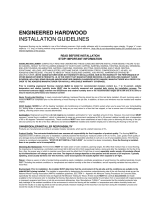 Americana Floors SB-PL-HRM35606 Installation guide
Americana Floors SB-PL-HRM35606 Installation guide
-
Mohawk HCC58-10 Installation guide
-
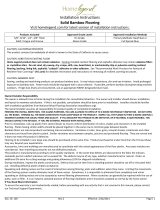 Home Legend HL43S Installation guide
Home Legend HL43S Installation guide
-
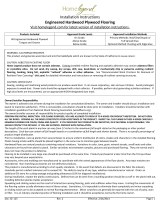 Home Legend HL65P Installation guide
Home Legend HL65P Installation guide
-
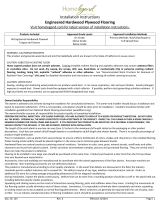 HOMELEGEND HL16P Installation guide
HOMELEGEND HL16P Installation guide
-
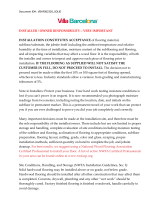 Malibu Wide Plank HDMCSS839SF Installation guide
Malibu Wide Plank HDMCSS839SF Installation guide
-
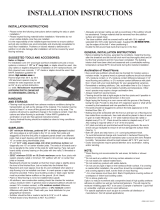 Blue Ridge Hardwood Flooring 20482 Installation guide
Blue Ridge Hardwood Flooring 20482 Installation guide
-
 Cali Hardwoods 7601002200 Installation guide
Cali Hardwoods 7601002200 Installation guide
-
Cali Bamboo 7003001000 Installation guide










